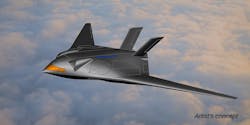Aurora Flight Sciences eyes developing X-plane demonstrator to showcase unmanned enabling technologies
ARLINGTON, Va. – Unmanned aerial vehicle (UAV) experts at Aurora Flight Sciences Corp. are moving forward with developing an X-plane to demonstrate enabling technologies in speed and runway independence for future crewed and unmanned aircraft.
Officials of the U.S. Defense Advanced Research Projects Agency (DARPA) in Arlington, Va. announced a $25 million order to Aurora Flight Sciences on Tuesday for phase 1B of the SPeed and Runway INdependent Technologies (SPRINT) program.
Aurora engineers will design, build, certify, and fly an X-plane to demonstrate enabling technologies for a combination of aircraft speed and runway independence for the next generation of crewed and unmanned aircraft.
Related: Aurora to build DARPA VTOL X-Plane technology demonstrator with hybrid-electric propulsion
Aurora won a $2.9 million DARPA SPRINT phase-one contract last November. Other companies taking part in the DARPA SPRINT program's first phase are Bell Textron Inc. in Fort Worth, Texas; Northrop Grumman Aeronautic Systems in Falls church, Va.; and Piasecki Aircraft Corp. in Essington, Pa.
Aurora will describe a scaled experimental X-plane demonstrator to validate the enabling technologies at a relevant size, and reach first flight of the demonstrator by April 2027. Aurora engineers first focused on conceptual design, and now will work on selected X-plane designs, and finally on limited detailed design.
Enabling technologies that Aurora will develop may help enable an aircraft to cruise at speeds from 400 to 450 knots, hover in austere environments, and switch quickly between these modes of operation.
The SPRINT X-plane is not to be a pre-production aircraft, but instead will be a proof-of-concept technology demonstrator to validate technologies that can scale to different-size military aircraft.
The runway-independent SPRINT X-plane should have useable flight hours left after the DARPA flight demonstration, and likely will be turned over to U.S. Special Operations Command for further evaluation.
On this contract Aurora will do the work in Manassas, Va., and St. Louis, and should be finished by June 2025. For more information contact Auroral Flight Sciences online at www.aurora.aero/2023/11/15/aurora-flight-sciences-to-design-high-speed-vertical-lift-x-plane, or DARPA at www.darpa.mil/program/speed-and-runway-independent-technologies.
About the Author
John Keller
Editor-in-Chief
John Keller is the Editor-in-Chief, Military & Aerospace Electronics Magazine--provides extensive coverage and analysis of enabling electronics and optoelectronic technologies in military, space and commercial aviation applications. John has been a member of the Military & Aerospace Electronics staff since 1989 and chief editor since 1995.
